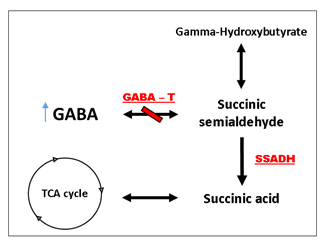GABA-Transaminase (GABA-T) is the initial key enzyme involved in gamma-aminobutyric acid (GABA) degradation. Deficiency of this enzyme is inherited in an autosomal recessive pattern and was initially reported in 1984, with two cases reported in the same family suggesting mortality within the first two years of life. Only a small number of affected individuals have been published, although more cases are being identified with increasing use of phenotype specific gene panels and whole exome sequencing.

Figure 1: Gamma-aminobutyric acid (GABA) degradation pathway. GABA is normally converted via GABA-transaminase into succinate semialdehyde, which is then broken down to succinic acid by succinate semialdehyde dehydrogenase (SSADH). The absence of GABA-T leads to increased endogenous GABA in brain. The absence of SSADH, succinate semialdehyde is converted to Gamma-Hydroxybutyrate (GHB) rather than succinic acid, and this leads to increased endogenous GABA and GHB in the brain.
GABA-T locates to the 4-aminobutyrate aminotransferase (ABAT) gene at chromosome 16p13.2. The concentration of free GABA in CSF has been shown to be as high as 60 times greater (in the index case) than in controls. Diagnosis may be predicated on the measurement of CSF amino acid concentrations, with elevations in free and total GABA and beta-alanine. There is no CSF elevation of GHB. Metabolomic profiling may be informative by the detection of the GABA keto-analogue 2-pyrrolidinone in plasma, urine, or CSF. Rarity of this disorder may be due to in utero death or infrequency of recessive alleles, but diagnosis is likely impeded by the general lack of availability of CSF testing for GABA concentrations. MR spectroscopy with special editing for small molecules has been used as an alternative to CSF to make this diagnosis.
The ABAT enzyme has recently been discovered to have a dual function. ABAT deficiency results in both a neurometabolic disorder as described, as well as a mitochondrial genome depletion syndrome, where there is a marked loss of mitochondrial genome (mtDNA) copy number. ABAT plays an essential role in mitochondrial nucleoside salvage by aiding in the production of deoxynucleotide triphosphate (dNTP) from deoxynucleotide diphosphate (dNDP) in the mitochondria, the building block for DNA.
